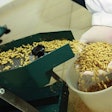
From sanitation to loading, maintaining the quality of grain in storage begins at harvest — starting with cleaning the empty bins. The time to spring into action and clean is now according to Dirk Maier, professor of grain science and industry at Kansas State University.
“If you clean your bins now, then you don’t have to worry about it at harvest,” Maier says adding that this is also the time to take care of storage structure issues such as leaks in the bin walls and roof. The quality of grain cannot be improved, just maintained; thus it’s vital that the grain bins are free of rodents, insects, spoiled corn and rust before bringing in the new harvest.
Maier suggests the following steps to prepare for the 2015 harvest:
1.Clean bins in advance. Sanitize bins completely of residual grain with either a broom or a shop vacuum. Make sure roof vents are clear of debris, and clean beneath the floor to eliminate insect harborage.
2. Take care of storage structures. Paint over rusted areas. Make sure that after removing spoiled corn from the walls or floor of the bin that you repaint the area to avoid rusting.
3. Check for holes in the floor to avoid grain spilling into the plenum, and look for holes in the roof where water and snow can come through.
4. Make sure fans are covered when not in use.
Prepare corn for storage
“One of the most important things you do to keep grain quality high needs to be done in the fall,” says Iowa State University professor of agriculture and biosystems engineering Charles Hurburgh. He advises to never let grain sit warm in a truck.
“It’s like a carton of milk: There is a shelf life for milk that is kept at a certain temperature. But if I set the carton of milk on the counter and it warms up to 45 F, then its shelf life won’t be as long,” says Hurburgh.
Cleaning the wet corn of fines and foreign material also needs to be done before the corn goes into the bin. Even after cleaning the corn, it may still be necessary to core the bin to remove the broken kernels and debris that clog the center of the bin. Removing the fines allows the corn to properly aerate.
Aerate properly for maximum quality
There are better times to aerate than others — even in the winter. As a rule of thumb, aerate corn on low humidity days when the dew point is below the air temperature. However, when spring comes it is best to seal the fans and let the grain aerate naturally to avoid increasing the temperature.
“If you aerate the grain during the winter, it will stay around 35 F,” says Klein Ileleji, associate professor and Extension engineer at Purdue University. He adds that it’s best not to aerate in the spring to allow the grain to stay colder longer.
“During the spring steel bins warm up the outside of the corn next to the bin wall, but the center is still cold causing a convective current — the warm air rises while the cold air moves down,” he says. “However, convective currents do not lead to drastic moisture movements.”
The ability for the corn to stay cool longer because of its good insulation properties means less insect damage and longer storage life through the summer months.
Maintaining the quality of harvest 2014
According to Hurburgh, the grace period is over for producers to store their 2014 harvest, so they should be moving grain to the elevator. This incoming corn may need to be dried. Hurburgh said that as of April 15, there were still reports of 18% moisture corn.
“There was a fair amount of wet corn harvested last year — not like in 2009 with 20% moisture — averaging 18% moisture,” says Hurburgh. “If it wasn’t attended to or monitored, we will have spoiled corn.”
With a cool 2014 harvest season, the temptation was to put high-moisture corn into bins rather than to let it dry first. To avoid spoilage Hurburgh advises keeping a close eye on the temperature.
“A 2- to 3- degree rise in temperature over a couple of weeks is a big signal that the grain is starting to heat,” he says.
If heating is detected, turn on the fans and dry the grain, or run the grain back through the dryers, but monitor moisture closely to avoid overdrying the grain.
Monitor moisture
“You want to address the moisture right away,” Ileleji says. “It’s good to have monitoring systems in place so that you can manage the quality of the grain and be profitable.” If the grain is stored at 16% moisture, then record the temperature daily and moisture content monthly, but 17% moisture grain should be checked every few days. “The more susceptible the corn is to spoilage, the more often it needs to be checked,” he says.
Manage outdoor storage
Ileleji gives special caution for grain that is kept in temporary storage such as grain bags. “These don’t protect grain as well as a silo because of the likelihood of damage to the bags, which make stored grain more susceptible to spoilage,” he says, explaining that grain bags that are secured airtight and undamaged work well.
Temporary bags store dry grains that are around 14% to 15% moisture and moderately wet grains that are around 16% to 18% quite well. He adds that it’s important to store bags where it is easy to monitor and manage the grain.
Similarly, elevators that store corn in outdoor piles also need to monitor and manage the grain closely. Ileleji advises grain handlers to move the outdoor piles of grain before the end of spring when the weather begins to be steadily warm.
“It is important that once the pile has been opened up that all the corn is moved,” Hurburgh says. “Poorly piled corn has a lot of bad press.” But he says that a stadium type of corn storage that is well-managed, i.e., clean grain, dry corn, well distributed with the tarp sealed and proper aeration, can maintain quality grain.
“The claim for outdoor storage is that it is cheap,” Hurburgh says. “If you want to use it for a couple of months, then you need to manage it properly to get more value out of the grain.”
Minimize insect damage
Temperature and moisture are the biggest contributors to insect damage. “If you can hold the temperature down longer into July, this will delay insect growth,” says Ileleji, noting that elevators turn away loads of grain if three to five live beetles or two live weevils are found in the load.
Long storage times expected to continue
With grain expected to stay in storage into 2016, managing and monitoring the grain moisture and temperature conditions is vital to ensure grain quality is maintained. According to the March 31 USDA Grain Stocks Report, 4.38 billion bushels of corn are currently in storage on U.S. farms. And an additional 89.2 million acres of corn are predicted to be planted in 2015.
While the grain handlers may have little control over grain prices, they do have control over how well grain is stored, managed and monitored. As a rule of thumb, grain handlers are advised to follow the Sanitation, Loading, Aeration and Monitoring (SLAM) concept (see sidebar above). Grain quality cannot be improved while in storage, but the quality can be maintained in order to reap high profits.
Subscribe to Magazine

















